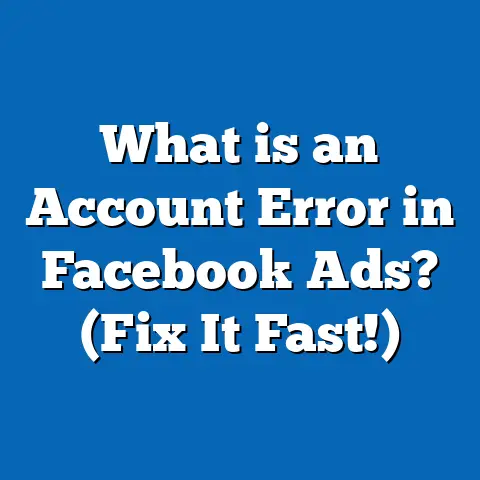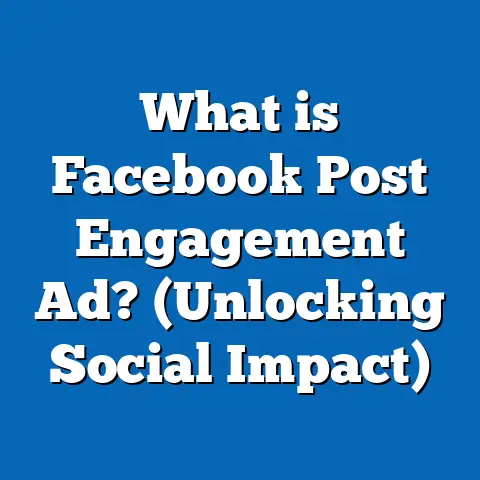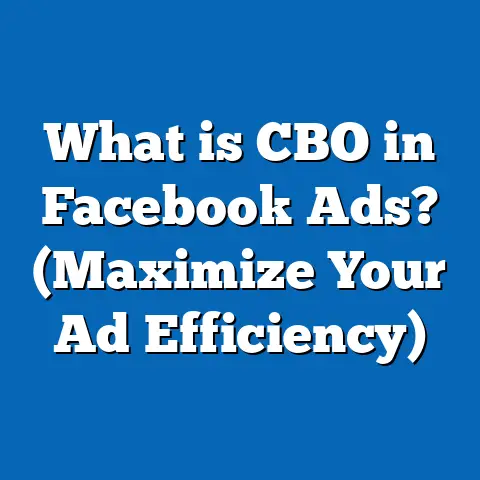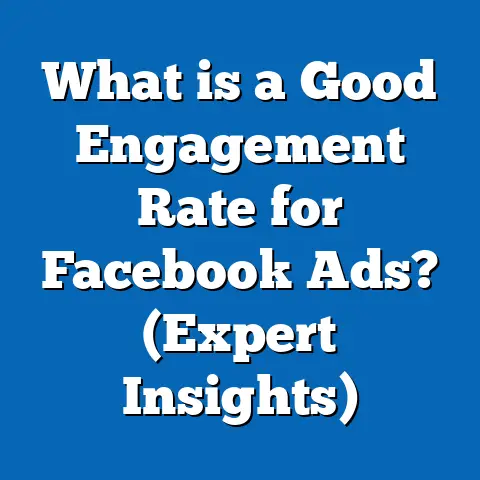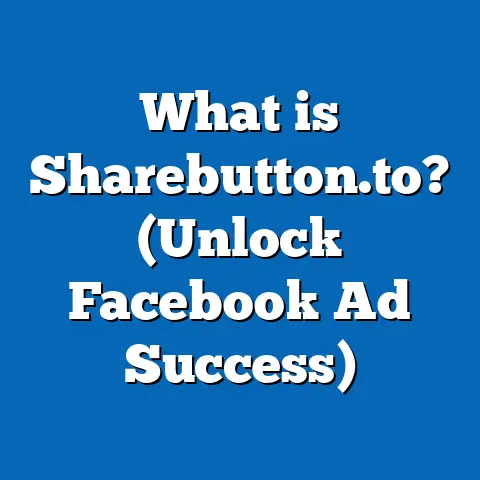What is Facebook Ad Optimization? (Maximize Your ROI)
What is Facebook Ad Optimization? (Maximize Your ROI)
Introduction: The High-Stakes World of Facebook Advertising
Imagine pouring thousands of dollars into Facebook ads every month only to watch your budget disappear with little to no meaningful results. It’s like throwing money into a black hole. For many businesses, this is the harsh reality—advertising budgets spent without a clear path to conversions or sales. But what if you could change that narrative? What if you could transform every ad dollar into measurable growth and profit?
Facebook ad optimization is the key. It’s what separates successful marketers from those who waste resources. In a marketplace where digital ad spending hit over $250 billion globally in 2024, mastering Facebook ad optimization is no longer optional; it’s essential.
Facebook’s advertising platform is complex and constantly evolving. The algorithm, targeting options, bidding systems, and creative formats change frequently. Without a deep understanding of optimization, even experienced marketers can struggle to keep pace.
Understanding Facebook Ad Optimization
What Exactly Is Facebook Ad Optimization?
Facebook ad optimization is the process of continuously improving your advertising campaigns to maximize performance against your specific goals. Whether you want more clicks, leads, app installs, or purchases, optimization involves:
- Refining audience targeting
- Testing and improving creatives
- Adjusting bidding strategies
- Choosing optimal placements
- Monitoring performance metrics
- Reacting quickly and iterating based on data
The objective is to increase efficiency — getting more results for less spend. It turns what could be a costly experiment into a scalable revenue stream.
Why Is Facebook Ad Optimization So Vital?
The importance of Facebook ad optimization can be seen through hard data:
- Average Cost Per Click (CPC) on Facebook varies by industry but generally ranges from $0.50 to $3.00 globally (WordStream, 2024). Without optimization, costs often skew higher.
- Marketers who actively optimize campaigns experience up to 30%-50% lower CPC and 20%-40% higher conversion rates than those who don’t.
- A 2024 report from Facebook Business shows advertisers using automated optimization tools like Campaign Budget Optimization (CBO) and dynamic creatives achieve up to 25% higher Return on Ad Spend (ROAS).
- Conversely, unoptimized campaigns waste up to 70% of ad spend on irrelevant audiences and low-performing creatives.
As competition intensifies on the platform, the cost of inefficiency grows. Optimizing ads isn’t just smart; it’s critical for survival.
Core Elements of Facebook Ad Optimization
To optimize Facebook ads effectively, you must master several interconnected components.
Audience Targeting Optimization
Facebook’s targeting capabilities are among its strongest assets. Proper audience selection drives relevance and efficiency.
Types of Audiences:
- Core Audiences: Target based on demographics (age, gender), location, interests, behaviors, and device use.
- Custom Audiences: Retarget users who have interacted with your brand—website visitors, app users, email subscribers.
- Lookalike Audiences: Reach new people similar to your best customers by analyzing common traits in a source audience.
Why Targeting Matters
Your ads should reach users most likely to convert. For example:
- A study by AdEspresso showed retargeting website visitors resulted in a 70% higher conversion rate compared to cold prospecting.
- Lookalike Audiences typically deliver 2x higher ROAS than broader interest targeting.
Advanced Targeting Tips:
- Layer multiple targeting criteria for precision.
- Exclude irrelevant segments to reduce wasted spend.
- Refresh Custom Audiences regularly to avoid saturation.
- Use engagement-based Custom Audiences (e.g., video viewers) for warm retargeting.
Creative Optimization
Creative elements—images, videos, headlines, and copy—are the visual and verbal hooks that capture attention.
Why Creative Matters
Facebook ads compete in crowded feeds where users scroll fast. Engaging creatives increase click-through rates (CTR) and reduce cost per result.
Data Highlights:
- Video ads generate 6x higher engagement than static images (Facebook IQ).
- Ads with emotional triggers or urgency in headlines see CTR increases of 12-15%.
- Carousel ads allow showcasing multiple products or features, boosting interaction by up to 24% compared to single-image ads.
Best Practices:
- Test multiple creative variations using split testing.
- Keep messaging clear and aligned with your target audience’s pain points.
- Use high-quality visuals optimized for mobile.
- Rotate creatives regularly to avoid ad fatigue—ad fatigue can increase CPC by as much as 50%.
Placement and Delivery Optimization
Facebook offers a variety of ad placements across platforms including:
- Facebook Feed
- Instagram Feed and Stories
- Messenger Inbox
- Audience Network (partner apps/websites)
- Reels (short-form videos)
Choosing Placements
Each placement has different engagement levels and costs:
- Mobile feed placements tend to drive 75% of conversions for many advertisers.
- Stories and Reels offer immersive full-screen experiences with high engagement but can have higher CPC.
- Audience Network extends reach but may deliver lower quality traffic depending on campaign goals.
Automatic Placements vs Manual Placements
Using automatic placements allows Facebook’s machine learning to optimize delivery based on performance data. Studies show automatic placement campaigns outperform manual by roughly 20% in cost-efficiency.
For niche campaigns or specific branding goals, manual placements can be tested but require careful monitoring.
Bidding and Budget Optimization
Bidding strategies directly influence how much you pay per action and how often your ads show.
Facebook Bidding Options:
- Lowest Cost (Auto-bid): Facebook aims for lowest cost per result within budget.
- Cost Cap: Controls max cost per result while maximizing volume.
- Bid Cap: Sets a hard max bid limit (manual bidding).
- Target Cost: Maintains a stable cost per result over time.
Which Bidding Strategy to Choose?
Most advertisers start with lowest cost, allowing Facebook’s algorithm to optimize delivery.
However,
- Cost cap bidding works well when you want predictable CPA (cost per acquisition).
- Manual bid caps offer control but can limit delivery if set too low.
Budget Allocation
Optimizing budgets means shifting spend dynamically:
- Allocate more budget toward top-performing ad sets.
- Pause or reduce budgets on underperformers quickly.
- Use Campaign Budget Optimization (CBO) to let Facebook distribute budget automatically across ad sets based on real-time performance.
According to a 2024 survey by Social Media Examiner, advertisers who review and adjust budgets daily see 30% better ROI than those who set-and-forget.
Data Backed Insights: The Impact of Effective Optimization
Optimization transforms campaign metrics significantly. Consider this comparison:
| Metric | Without Optimization | With Optimization | Improvement |
|---|---|---|---|
| Cost Per Click (CPC) | $1.20 | $0.84 | 30% lower |
| Conversion Rate | 2.5% | 3.5% | 40% higher |
| Return on Ad Spend (ROAS) | 2x | 3x | 50% higher |
| Ad Engagement Rate | 1.8% | 4.0% | 122% higher |
(Source: Facebook Business Insights 2024)
These improvements translate into significant revenue gains when scaled across campaigns.
Advanced Strategies for Facebook Ad Optimization
Harnessing Machine Learning & AI Tools
Facebook leverages powerful AI to optimize ad delivery automatically when provided with enough data.
Tools to Use:
- Campaign Budget Optimization (CBO): Automatically distributes budget among ad sets based on their performance potential.
- Dynamic Creative Ads: Upload multiple assets (images, headlines, descriptions), and Facebook dynamically tests combinations.
- Automatic Placements: Let Facebook decide where ads perform best across its family of apps.
A Shopify case study showed brands using CBO increased ROAS by up to 35% versus manual budget allocation.
Conversion API (CAPI): The New Standard in Tracking
With growing privacy regulations like iOS 14+ app tracking restrictions, traditional pixel tracking became less reliable.
Conversion API allows advertisers to send web events directly from their servers to Facebook’s servers—bypassing browser limitations.
Benefits include:
- Up to 20% increase in attributed conversions.
- More accurate event data leads to better optimization.
Many leading advertisers now rely on CAPI alongside Pixel tracking for best results.
Systematic Testing & Experimentation
Optimization requires constant testing. Follow a structured framework:
- Set Hypotheses: What element are you testing? For example, “Will video ads outperform images?”
- Run A/B Tests: Split audiences randomly to compare performance.
- Analyze Statistical Significance: Look beyond raw numbers; use tools like Facebook’s built-in split testing reports.
- Iterate Quickly: Scale winning tests; pause poor performers promptly.
- Document Learnings: Maintain a log of test results for ongoing improvement.
Successful marketers run tests continuously—never settling for “good enough.”
Comparing Facebook Ad Optimization with Other Platforms
Understanding where Facebook fits relative to other major platforms helps refine strategy.
| Feature | Facebook Ads | Google Ads | LinkedIn Ads |
|---|---|---|---|
| Audience Targeting | Highly granular; interests, behaviors | Keyword & intent based | Professional & B2B focused |
| Creative Formats | Image, Video, Carousel | Text & display ads | Sponsored content & InMail |
| Automation Tools | Strong machine learning | Advanced bidding algorithms | Emerging automation features |
| Cost Efficiency | Moderate CPC ($0.97 avg) | Higher CPC ($1-$2 avg) | Highest CPC ($5+ avg) |
| Best For | Broad & niche audience reach | Intent-driven search traffic | B2B lead generation |
Facebook excels at broad awareness and direct-response campaigns thanks to its advanced targeting and creative flexibility.
Real World Case Studies Showing Impact of Optimization
Case Study 1: E-Commerce Brand Boosts Sales by 60%
A mid-sized fashion retailer used layered audience targeting combined with dynamic creative testing and CBO.
Steps taken:
- Created Custom Audiences from past purchasers.
- Tested video vs static image ads.
- Allowed CBO for automatic budget allocation between ad sets.
Results after 3 months:
- CPC dropped from $1.10 to $0.75.
- ROAS increased from 2x to 3.5x.
- Conversion rate improved by 45%.
Case Study 2: SaaS Company Improves Lead Quality & Lowers CPL
A SaaS provider focusing on lead generation optimized their campaign by:
- Building Lookalike Audiences from highest-value customers.
- Implementing Conversion API for enhanced tracking accuracy.
- Switching bidding strategy from lowest cost to cost cap for stable lead pricing.
Results:
- Lead conversion rate increased by 35%.
- Cost per lead decreased by 28%.
This allowed the company to scale efficiently without inflating costs.
Step-by-Step Guide: How to Start Optimizing Your Facebook Ads Today
Step 1: Define Clear Objectives
Before launching ads, establish what success looks like—awareness, clicks, leads, sales—and set measurable KPIs accordingly.
Step 2: Install Tracking Tools Correctly
Ensure proper setup of:
- Facebook Pixel on your website
- Conversion API integrated with your backend This ensures accurate data collection for optimization.
Step 3: Segment Your Audience Strategically
Build Custom Audiences from website visitors or email lists. Create Lookalike Audiences based on best customers. Layer interest and behavior filters for prospecting.
Step 4: Develop Multiple Creative Variations
Create at least three different creatives per campaign—vary images/videos/headlines—to test what resonates best.
Step 5: Choose Appropriate Bidding Strategies
Start with automatic lowest cost bidding; test cost caps if you need predictable CPA control.
Step 6: Enable Campaign Budget Optimization (CBO)
Allow Facebook’s algorithm to dynamically allocate budget across ad sets for best overall results.
Step 7: Monitor Campaigns Daily & Adjust
Pause low performers quickly; increase budgets on winners. Use real-time data dashboards like Facebook Ads Manager or third-party tools.
Step 8: Run Ongoing A/B Tests
Test new audiences, creatives, placements regularly. Document findings for continuous improvement.
Step 9: Analyze Data Thoroughly
Look beyond surface metrics; evaluate conversion rates, cost per acquisition, frequency, relevance scores.
Step 10: Stay Informed About Platform Updates
Facebook changes rapidly—follow official updates on privacy rules, new features like Reels ads or AI tools that impact optimization strategies.
Common Challenges & How To Overcome Them
Challenge: Ad Fatigue Leading to Performance Decline
Solution: Rotate creatives frequently; refresh audiences every few weeks; increase frequency caps cautiously.
Challenge: Attribution Gaps Due to Privacy Changes
Solution: Implement Conversion API alongside Pixel; use aggregated event measurement settings in Events Manager; diversify channels for attribution clarity.
Challenge: Scaling Without Increasing Costs
Solution: Focus on Lookalike Audiences with high similarity percentages; layer interest targeting; use CBO for automatic budget scaling; test new creatives constantly to avoid saturation.
Challenge: Confusing Metrics & Data Overload
Solution: Prioritize key KPIs aligned with objectives; use custom dashboards; avoid vanity metrics like impressions unless they directly support goals.
Future Trends in Facebook Ad Optimization
AI-Powered Creative Generation
AI tools will increasingly create ad copy and visuals tailored dynamically to audiences—reducing manual testing burden.
Increased Automation & Predictive Bidding
Facebook will enhance predictive analytics allowing advertisers to preemptively adjust bids and budgets based on forecasted trends.
Privacy-Focused Targeting Innovations
New methods combining first-party data with privacy-safe signals will emerge as iOS restrictions tighten further.
Summary & Final Takeaways
Facebook ad optimization is an indispensable skill in digital marketing today. It involves refining every aspect of your campaigns—from audience targeting and creative development to bidding strategies and placement choices—to maximize return on investment.
Key points to remember:
- Start with clear goals and proper tracking setup.
- Use data-driven testing of multiple audiences and creatives.
- Leverage Facebook’s machine learning tools like CBO and dynamic creative ads.
- Implement advanced tracking via Conversion API for better attribution.
- Continuously monitor performance daily and adjust budgets accordingly.
- Run structured A/B tests regularly and iterate quickly based on results.
- Stay updated on platform changes affecting privacy, targeting, and formats.
By applying these principles rigorously, marketers can reduce wasted spend dramatically while driving conversions at scale—turning Facebook ads from cost centers into profit engines.

